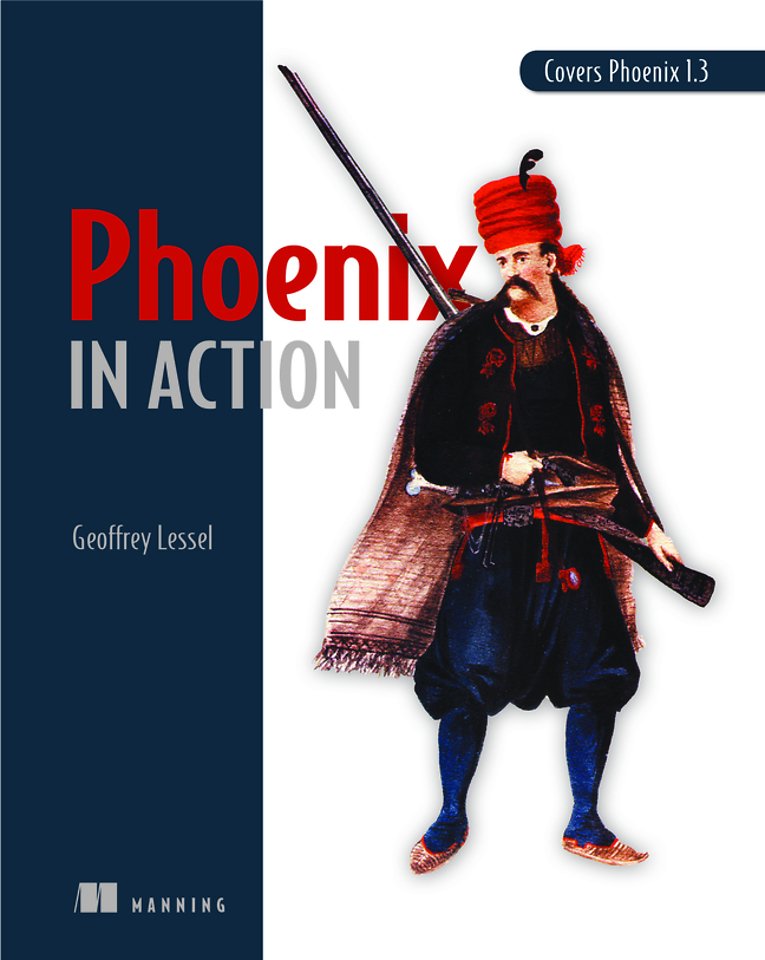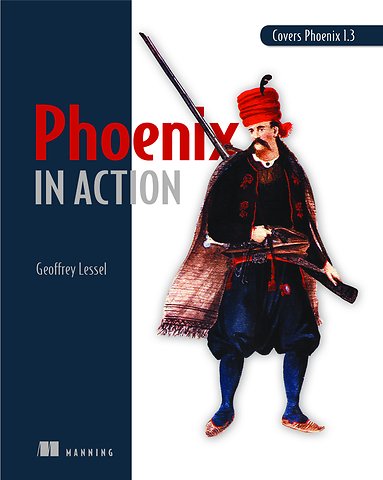


Geoffrey Lessel is a seasoned web developer who speaks and blogs about Elixir and Phoenix.
Meer over Geoffrey LesselPhoenix in Action
Covers Phoenix 1.3
Paperback Engels 2019 1e druk 9781617295041Samenvatting
Modern web applications need to be efficient to develop, lightning fast, and unfailingly reliable. Phoenix, a web framework for the Elixir programming language, delivers on all counts. Elegant and intuitive, Phoenix radically simplifies the dev process. Built for concurrency, Phoenix channels make short work of developing real-time applications. And as for reliability, Phoenix apps run on the battle-tested Erlang VM, so they’re rock solid!
'Phoenix in Action' is an example-based book that teaches you to build production-quality web apps. You’ll handle business logic, database interactions, and app designs as you progressively create an online auction site. As you go, you’ll build everything from the core components to the real-time user interactions where Phoenix really shines.
What's inside
- Functional programming in a web environment
- An introduction to Elixir
- Database interactions with Ecto
- Real-time communication with channels
For web developers familiar with a framework like Rails or ASP.NET. No experience with Elixir or Phoenix required.
Specificaties
Lezersrecensies
Inhoudsopgave
1 RIDE THE PHOENIX
1.1 What is Phoenix?
1.2 Elixir and Phoenix vs. the alternatives
1.2.1 Real-time communication
1.2.2 Efficient, small processes
1.2.3 Background computation
1.2.4 Minimal hardware requirements, low-cost scaling
1.2.5 It’s not all roses
1.3 The power of Elixir
1.3.1 Scalability
1.3.2 Supervision trees
1.3.3 Erlang VM
1.3.4 Macro and metaprogramming support
1.3.5 OTP
1.4 Functional vs. object-oriented programming
1.4.1 Overview of functional programming
1.5 Keep reading
Summary
2 INTRO TO ELIXIR
2.1 The basics
2.1.1 IEx
2.1.2 Basic types
2.1.3 A small detour into functions
2.1.4 Data type details
2.1.5 Back to modules and named functions
2.1.6 alias
2.1.7 import
2.2 Other idiomatic Elixir language features
2.2.1 The pipe operator
2.2.2 Pattern matching
2.2.3 Using IEx.Helpers.v/1
Summary
3 A LITTLE PHOENIX OVERVIEW
3.1 Follow the data
3.1.1 The basics of a web request
3.1.2 Endpoint
3.1.3 Router
3.1.4 Controller
3.1.5 Views
3.1.6 Templates
3.2 Putting it all together
Summary
PART 2: DIVING IN DEEP
4 PHOENIX IS NOT YOUR APPLICATION
4.1 I thought this book was about Phoenix
4.2 The first steps in building your application
4.2.1 Defining an item
4.2.2 Adding a fake database
4.2.3 Getting an Item by id
4.2.4 Getting an Item based on other information
4.3 Next steps
Summary
5 ELIXIR APPLICATION STRUCTURE
5.1 Moving from a single file to an application
5.1.1 Using Mix to create a new application
5.1.2 Generating an auction umbrella application
5.1.3 The magic mix.exs file
5.2 Organizing, compiling, and running your new application
5.2.1 Breaking apart the three modules
5.2.2 Compile and run!
5.2.3 Running the Auction application for the first time
5.3 Using hex to get external dependencies
5.3.1 Pulling in your dependencies
Summary
6 BRING IN PHOENIX
6.1 Installing Phoenix on your system
6.2 Creating a new Phoenix application
6.2.1 Running your server for the first time
6.3 Listing items from the fake repo
6.3.1 Modifying the controller and template
Summary
7 BEING PERSISTENT WITH A DATABASE
7.1 A quick intro to Ecto
7.2 Configuring Ecto
7.2.1 Using Ecto’s Mix tools to set up your database
7.3 Preparing Auction to use the database
7.3.1 Defining the Auction.Item schema
7.3.2 Migrating the database
7.3.3 Pointing the public interface to the new repo
7.3.4 Instructing the application to supervise the database connection
7.3.5 Testing it out
7.4 Creating, retrieving, and deleting data in the database
7.4.1 Inserting data
7.4.2 Retrieving data
7.4.3 Deleting data
7.4.4 Updating data
7.4.5 What about the website?
Summary
8 MAKING CHANGES WITH ECTO.CHANGESET
8.1 Can’t I just … update?
8.1.1 A brief intro to changesets
8.1.2 Creating a changeset for Auction.Item
8.2 Now you can update!
8.2.1 Adjusting the public interface for updating
Summary
9 TRANSFORMING DATA IN YOUR BROWSER
9.1 Handling new routes in your application
9.1.1 Adding a new route
9.1.2 Adding a new controller
9.1.3 Adding a new view
9.1.4 Adding a new template
9.2 Viewing the details of a single item
9.2.1 Defining the show route and function
9.2.2 Defining the show.html template
9.2.3 Linking to individual items
9.3 Creating items through web forms
9.3.1 Defining the new and create routes
9.3.2 Defining the “new” controller function
9.3.3 Defining the “new” template
9.3.4 Defining the create controller function
9.4 Editing items through web forms
9.4.1 Defining the edit and update routes
9.4.2 Defining the “edit” controller function
9.4.3 Defining the edit.html.eex template
9.4.4 Defining AuctionWeb.ItemController.update/2
Summary
10 PLUGS, ASSIGNS, AND DEALING WITH SESSION DATA
10.1 Preparing your application for user registration
10.1.1 Defining the Auction.User schema
10.1.2 Creating a migration to create the users table
10.1.3 Defining changesets for Auction.User
10.1.4 Creating API functions in Auction
10.1.5 User registration web flow
10.2 Handling user login and sessions
10.2.1 Creating the route, controller, view, and templates for logging in and out
10.2.2 Implementing the dirty details of sessions and authentication
10.3 Plugs
10.4 Adding site navigation
10.4.1 Implementing the log out function
10.5 Restricting users from certain pages
Summary
11 ASSOCIATING RECORDS AND ACCEPTING BIDS
11.1 Creating bids
11.2 Adding associations to the Auction.Bid schema
11.2.1 A little detour into associations
11.2.2 Creating a migration that describes the associations
11.2.3 Creating a form to accept bids
11.3 Using has_many with items and users
11.3.1 Preloading and avoiding N+1 queries
11.3.2 Preloading associations in the public interface module and controller
11.3.3 Adding the list of bids to the view template
11.4 Listing a user’s bids on their profile page
11.4.1 Using Ecto.Query to construct database queries
11.4.2 Making a view helper function global and using the bids assign
11.4.3 Using Timex to format dates and times
11.5 Some ideas for further improvement
Summary
PART 3: THOSE IMPORTANT EXTRAS
12 USING PHOENIX CHANNELS FOR REAL-TIME COMMUNICATION
12.1 What are Phoenix channels?
12.2 Connecting a user to a channel and a topic
12.2.1 Handling topic join requests
12.2.2 Getting the user’s browser to join a topic
12.3 Sending real-time messages to a user
12.3.1 Receiving messages in the user’s browser
12.3.2 Configuring the channel to handle messages
12.3.3 Sending your browser a message from IEx
12.4 Updating all users when a new bid is made
12.4.1 Refactoring the rendering of an item’s bids
12.4.2 Modifying the controller to broadcast a message
12.4.3 Handling the broadcasted HTML in the browser
Summary
13 BUILDING AN API
13.1 Scoping API requests to a new controller
13.2 Creating the AuctionWeb.Api.ItemController controller and view
13.3 Including related bid and user data
Summary
14 TESTING IN ELIXIR AND PHOENIX
14.1 An introduction to ExUnit
14.1.1 Writing a first test
14.2 Setting up tests for Ecto
14.2.1 Configuring a new database
14.2.2 Creating a sandbox and configuring Ecto to use it in tests
14.2.3 Setting up the database before tests run
14.2.4 Creating a Mix alias for use during test runs
14.3 Testing Ecto queries in Auction
14.3.1 Testing Auction.list_items/0
14.3.2 Testing Auction.get_item/1
14.3.3 Testing Auction.insert_item/1
14.4 Simultaneously writing documentation and tests with doctests
14.4.1 Writing function-level documentation
14.4.2 Viewing documentation in IEx
14.4.3 Viewing documentation with ExDoc
14.4.4 Adding examples and doctests
14.4.5 Module-level documentation
14.5 Writing tests For Phoenix
14.5.1 Testing that an item is added to the database on success
14.5.2 Testing that you’re redirected to the new item on success
14.5.3 Testing that no item is created on error
14.5.4 Testing that the new item form is rendered on error
14.5.5 The entire ItemControllerTest module
14.6 What next?
Summary
APPENDIXES
APPENDIX A: INSTALLING ELIXIR AND PHOENIX
A.1 Installing Elixir
A.1.1 macOS and Unix/Linux variants
A.1.2 Windows
A.1.3 From source
A.1.4 Installing Erlang
A.2 Installing Phoenix
A.2.1 PostgreSQL
A.2.2 Node.js
APPENDIX B: MORE ELIXIR RESOURCES
Anderen die dit boek kochten, kochten ook
Rubrieken
- advisering
- algemeen management
- coaching en trainen
- communicatie en media
- economie
- financieel management
- inkoop en logistiek
- internet en social media
- it-management / ict
- juridisch
- leiderschap
- marketing
- mens en maatschappij
- non-profit
- ondernemen
- organisatiekunde
- personal finance
- personeelsmanagement
- persoonlijke effectiviteit
- projectmanagement
- psychologie
- reclame en verkoop
- strategisch management
- verandermanagement
- werk en loopbaan





